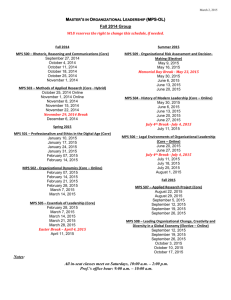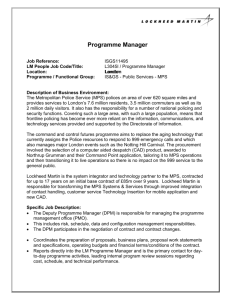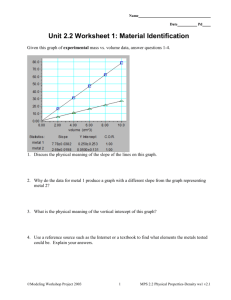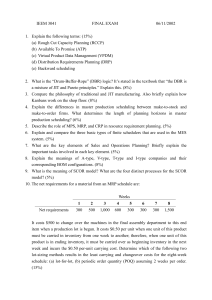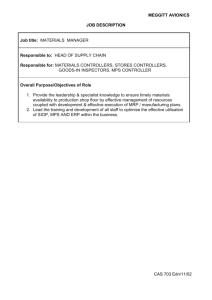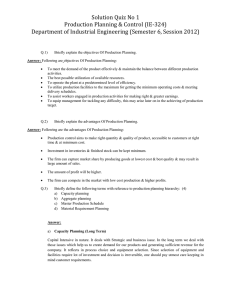Air Force Mission Planning System (MPS) Program, Increment II (F-15)
advertisement
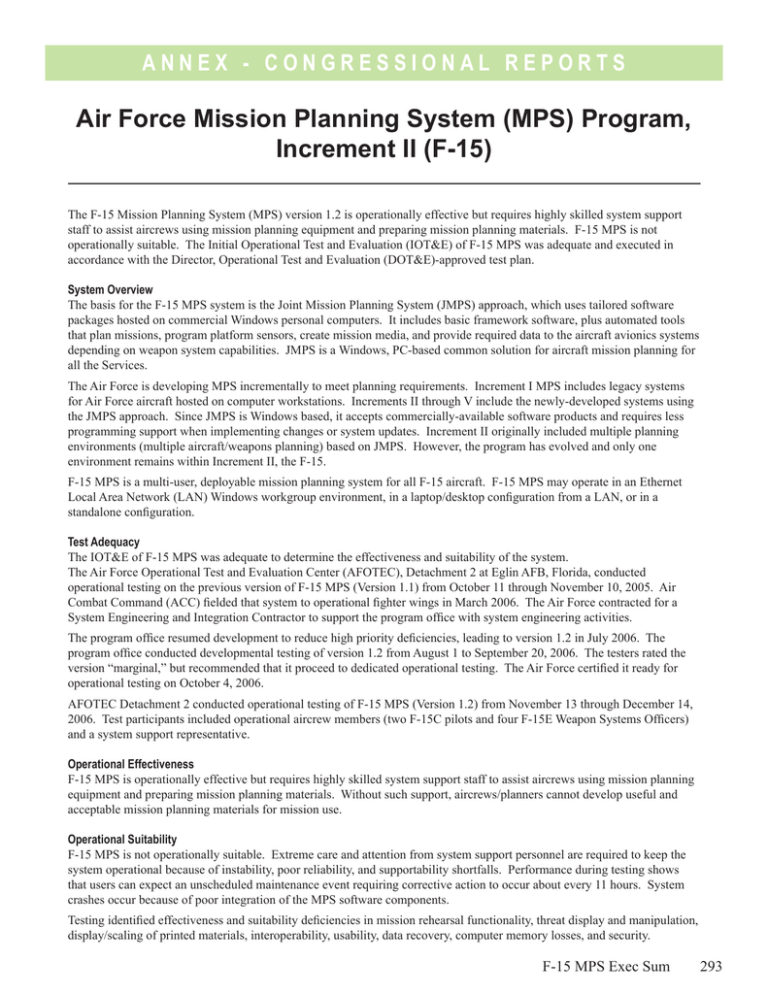
A nn e x - c o ng r e ss i o nal r e p o r ts Air Force Mission Planning System (MPS) Program, Increment II (F-15) The F-15 Mission Planning System (MPS) version 1.2 is operationally effective but requires highly skilled system support staff to assist aircrews using mission planning equipment and preparing mission planning materials. F-15 MPS is not operationally suitable. The Initial Operational Test and Evaluation (IOT&E) of F-15 MPS was adequate and executed in accordance with the Director, Operational Test and Evaluation (DOT&E)-approved test plan. System Overview The basis for the F-15 MPS system is the Joint Mission Planning System (JMPS) approach, which uses tailored software packages hosted on commercial Windows personal computers. It includes basic framework software, plus automated tools that plan missions, program platform sensors, create mission media, and provide required data to the aircraft avionics systems depending on weapon system capabilities. JMPS is a Windows, PC-based common solution for aircraft mission planning for all the Services. The Air Force is developing MPS incrementally to meet planning requirements. Increment I MPS includes legacy systems for Air Force aircraft hosted on computer workstations. Increments II through V include the newly-developed systems using the JMPS approach. Since JMPS is Windows based, it accepts commercially-available software products and requires less programming support when implementing changes or system updates. Increment II originally included multiple planning environments (multiple aircraft/weapons planning) based on JMPS. However, the program has evolved and only one environment remains within Increment II, the F-15. F-15 MPS is a multi-user, deployable mission planning system for all F-15 aircraft. F-15 MPS may operate in an Ethernet Local Area Network (LAN) Windows workgroup environment, in a laptop/desktop configuration from a LAN, or in a standalone configuration. Test Adequacy The IOT&E of F-15 MPS was adequate to determine the effectiveness and suitability of the system. The Air Force Operational Test and Evaluation Center (AFOTEC), Detachment 2 at Eglin AFB, Florida, conducted operational testing on the previous version of F-15 MPS (Version 1.1) from October 11 through November 10, 2005. Air Combat Command (ACC) fielded that system to operational fighter wings in March 2006. The Air Force contracted for a System Engineering and Integration Contractor to support the program office with system engineering activities. The program office resumed development to reduce high priority deficiencies, leading to version 1.2 in July 2006. The program office conducted developmental testing of version 1.2 from August 1 to September 20, 2006. The testers rated the version “marginal,” but recommended that it proceed to dedicated operational testing. The Air Force certified it ready for operational testing on October 4, 2006. AFOTEC Detachment 2 conducted operational testing of F-15 MPS (Version 1.2) from November 13 through December 14, 2006. Test participants included operational aircrew members (two F-15C pilots and four F-15E Weapon Systems Officers) and a system support representative. Operational Effectiveness F-15 MPS is operationally effective but requires highly skilled system support staff to assist aircrews using mission planning equipment and preparing mission planning materials. Without such support, aircrews/planners cannot develop useful and acceptable mission planning materials for mission use. Operational Suitability F-15 MPS is not operationally suitable. Extreme care and attention from system support personnel are required to keep the system operational because of instability, poor reliability, and supportability shortfalls. Performance during testing shows that users can expect an unscheduled maintenance event requiring corrective action to occur about every 11 hours. System crashes occur because of poor integration of the MPS software components. Testing identified effectiveness and suitability deficiencies in mission rehearsal functionality, threat display and manipulation, display/scaling of printed materials, interoperability, usability, data recovery, computer memory losses, and security. F-15 MPS Exec Sum 293 A nn e x - c o ng r e ss i o nal r e p o r ts Recommendations Operational Effectiveness • The Air Force should conduct end-to-end testing of mission planning systems, which includes aircraft flights and weapon releases whenever possible. • The MPS program office should conduct frequent user test events during remaining developmental efforts. AFOTEC should remain engaged, observe test events, and report on progress. • The Air Force should publish a Workaround Guide documenting deficiencies and corrections, review system support personnel unit manning, and continue steps to improve system integration and reduce system support workload. Operational Suitability • The MPS program office should apply the efforts of a system engineering and integration contractor to the maximum extent feasible. • The MPS program office should implement a program to resolve existing deficiencies and avoid proliferating known issues to other platform planning systems. Top priority should be to resolve system instability. Without increased system stability, the Air Force requires an increase in highly skilled system support personnel to sustain operations. • The MPS program office should implement a program to resolve potential new deficiencies created by full fielding. The MPS program office should poll users to identify critical issues that require resolution. • The MPS program office should update the logistics support concept and implement a program to ensure the availability of trained, highly skilled system support personnel. Corrections for deficiencies and inadequacies identified during testing require rigorous and thorough operational testing. The Air Force should review these test results when crafting test strategies and test plans for subsequent testing of later increments, and ensure the system builds on successes and learns from mistakes. 294 F-15 MPS Exec Sum

